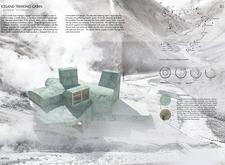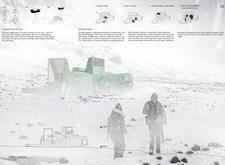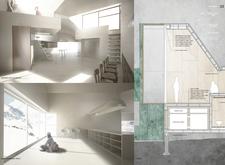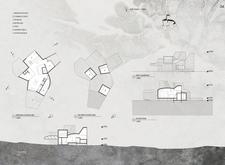5 key facts about this project
## Overview
The Iceland Trekking Cabin is situated within Iceland's rugged landscape, designed to serve as a shelter for travelers along the Landmannalaugar trail. The intent of the project is to provide comfortable accommodations while minimizing environmental impact. By integrating local materials and sustainable practices, this structure respects its natural surroundings and enhances the outdoor experience for its users.
### Architectural Configuration
The cabin features a distinctive form composed of flat and sloped roofs, integrated with vertical skylight towers. This design not only fosters a visual connection to the terrain but also minimizes the building’s footprint, thereby reducing disruption to the surrounding ecosystems. Internally, the spatial layout emphasizes social interaction, with elevated sleeping decks that offer views of the landscape while delineating private and communal areas. The main gathering space benefits from large windows that admit natural light, contributing to the warmth of the wooden interior.
### Material Selection and Sustainability
The materials used for the cabin are carefully chosen to align with its sustainable objectives. The exterior is clad in verdigris copper, which develops a natural patina over time, ensuring durability while harmonizing with the environment. Internally, plywood finishes provide a warm touch that contrasts with the harsh Icelandic climate. Lightweight wood studs and sheets facilitate efficient assembly in remote areas, while natural insulation enhances thermal performance. Additionally, the roof features special coatings that utilize solar energy for water heating.
The cabin incorporates a solar panel system to meet its energy needs completely, alongside roof-mounted rainwater collection and filtration systems to ensure water access. A natural septic system facilitates wastewater treatment, further embodying the project’s commitment to low environmental impact. Overall, the design blends innovative architecture with traditional building techniques, fostering a connection to Iceland's cultural heritage and demonstrating a model for sustainable construction in ecologically sensitive environments.





















































